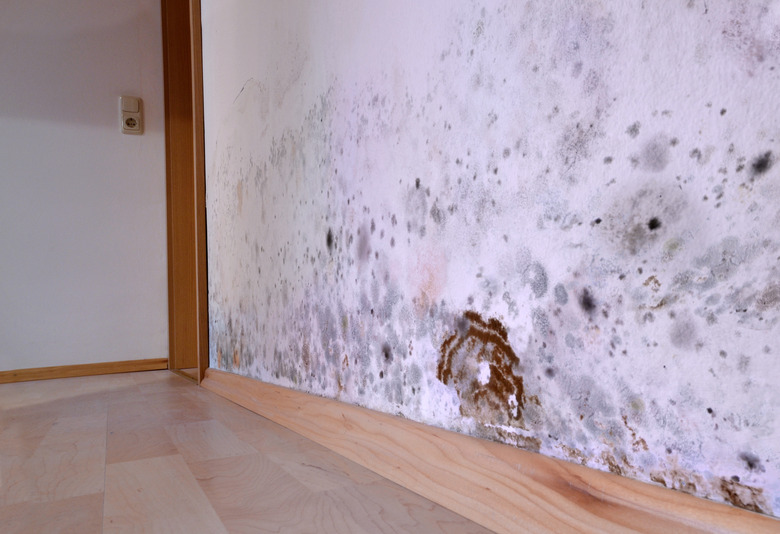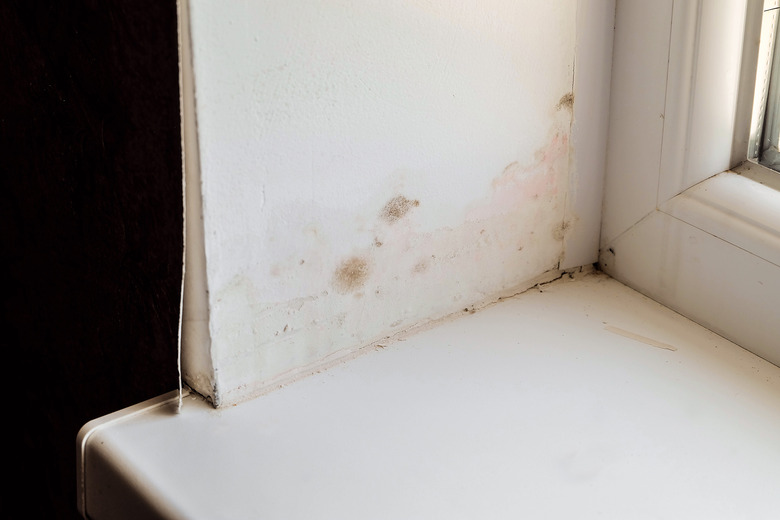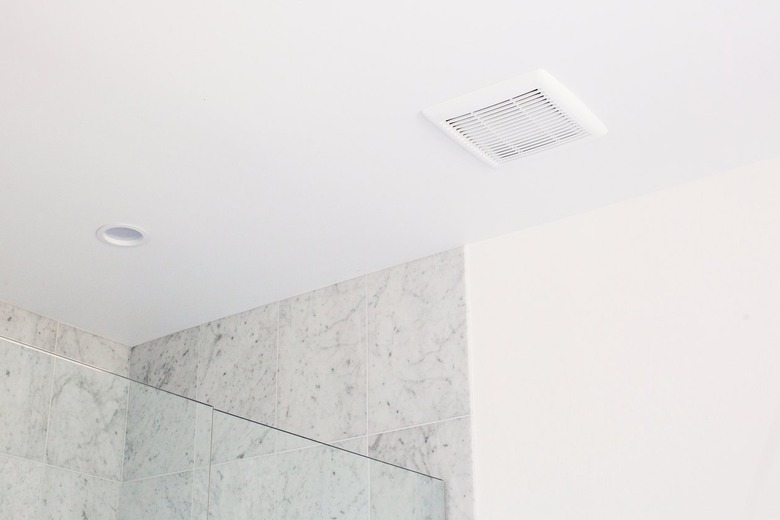Mold Growth In The Home: Everything You Need To Know
We may receive a commission on purchases made from links.
The spores necessary for mold growth are already present in your home. That may sound pretty gross, but the truth is that mold spores are everywhere. The good news is that mold doesn't have to be a big deal. There are many different types of mold besides the dreaded black mold (which can cause health problems, particularly if you are already vulnerable to respiratory illnesses), and you can clean up most molds without much fuss.
How It Got In
How It Got In
Maybe you're not Martha Stewart, but you keep a fairly clean house, use your bathroom and kitchen exhaust fans and occasionally clean with bleach. So, you might be wondering how mold spores are even living in your house. The answer is that they're everywhere. Mold spores are ubiquitous, and there's no escaping them.
Some get sucked in from the outside, making it through the filters in your heater or air conditioner. Some waft through open doors and windows on a summer breeze. Others ride in on your clothing as well as on your pets and even your grocery bags. No matter how careful you are or how meticulously you clean, there will always be at least a few mold spores present in your house, and they don't need much encouragement to take hold. Mold will unpack and quickly move into just about any damp space.
Types of Mold
Types of Mold
Experts divide the more than 100,000 strains of mold into three categories: toxic, pathogenic and allergenic. Toxigenic molds are the most dangerous, producing mycotoxins that can cause health issues even in healthy people. Stachybotrys, the infamous black mold, falls into the toxigenic category. Black mold isn't alone, however. Other toxigenic molds found in homes include Acremoneum and, under the right conditions, Trichoderma.
Pathogenic molds are those that probably won't make you sick if you're healthy. They may, however, aggravate or worsen existing health conditions (and at the very least contribute to poorer air quality). You can have trouble with these molds if your immune system is compromised in any way. Molds in this category include Aspergillus, Chaetomium, Ulocladium and Penicillium.
Other molds get classified as allergens. These molds may aggravate asthma or trigger an allergic reaction but otherwise cause no real harm. These include Mucormycetes, Alternaria, Aureobasidium pullulans, Cladosporium and Fusarium.
Mold and Your Health
Mold and Your Health
It is, of course, possible to have mold without experiencing any health effects, but not everyone gets that lucky. If you have mold allergies or are sensitive to mold, you may experience allergy symptoms that include worsening asthma, itchy eyes, wheezing, sneezing, itchy skin or a stuffy nose. Large amounts of mold can trigger fever and shortness of breath. Some people experience headaches.
More toxic molds can cause more serious problems. You may find that your sinuses and mucous membranes develop a burning sensation. Your chest may tighten, and you may develop a persistent cough, frequent nosebleeds or worsening headaches along with fatigue. Toxic mold exposure has been linked to neurological issues in children and pulmonary bleeding in infants, but more study is needed to determine the accuracy of those claims.
To Test or Not To Test
To Test or Not To Test
So, you found some mold, and you're not sure what kind it is. Should you test it? Actually, the answer is "no" because once you see mold, you need to take removal and remediation steps, period.
Since the mold removal process is the same for all molds, you really don't need to know what type of mold it is. Simply remove it using the recommended methods and safety precautions. If for some reason you do wish to have your mold tested, it's best to skip the home test kits and call in a professional who can properly secure a sample and do a visual inspection.
Although you don't need to test types of mold, there are times when you should test for the presence of mold. If you suspect hidden mold in your home or smell mold you don't see, a test is a good idea. You may also wish to test for the continued presence of mold after you do a cleanup to make sure you got everything. A mold presence test is also smart as part of a house inspection before buying a property or when you feel there is a mold problem, but your landlord disagrees.
Signs of Mold Growth
Signs of Mold Growth
Obviously, if you see mold, you have mold. Mold is sometimes more subtle, however, and grows in places where you can't see it, like behind your wallpaper or inside your walls. In this case, you're likely to smell the mold. You should also suspect mold if you know you have a water leak or water damage somewhere.
The smell is probably the only clue you'll get that mold is hiding somewhere, so follow your nose to the source. Mold likes to grow where there is condensation, including on walls behind furniture and near leaky plumbing pipes. Check around your windows for moisture problems and mold and examine the underside of your carpet. Books and newspaper piles are also places to check for mold.
Remove Mold Growth and Damage
Remove Mold Growth and Damage
Before you even think about cleaning up mold, it's imperative to find and fix the source of moisture that's feeding the mold. Mold caused by a slow plumbing leak will just come back if the leak isn't fixed, so make sure you solve the main problem before tackling the mold. When removing mold growth, it is important to dress for success. In this case, success means protecting yourself from mold spores so you don't suffer any ill effects. Always wear an N95 respirator, rubber gloves and safety glasses when cleaning up mold.
Start by removing things you can't clean. Moldy carpet, upholstery and drywall are often too porous for proper cleaning and need to be replaced. Scrub the items you can clean with a stiff-bristle scrub brush and some mild detergent (not ammonia). If you prefer, you can also use bleach solution at a maximum ratio of 1 cup of bleach to 1 gallon of water.
Tip
Never mix bleach with ammonia or other chemicals.
After cleaning, go over the area again with plain water to rinse it. Run a fan or dehumidifier when you clean and open doors and windows to help dry surfaces quickly after you clean them. Bring carpet, furniture and other items back into the area only after it's completely dry.
Saving Sentimental Items
Saving Sentimental Items
When mold growth is an issue, some items just aren't salvageable. Unfortunately, sometimes the items on which we find mold are very expensive or have sentimental value that makes them irreplaceable. In this instance, there are some steps you can take to try and save certain items. You might fail, but it's often worth a try.
Clothing and fabrics may be victims of permanent mold stains. To try and save them, pretreat the stain with an ammonia-free treatment or directly apply an ammonia-free laundry detergent. Let the stain soak in the detergent for a bit and then wash the item in the hottest water the fabric will tolerate. It's OK to add bleach to a white load or oxygen-based bleach for colors.
If you're trying to save leather, brush the mold away with a soft-bristled brush. After brushing, wipe down the leather with a phosphate-free detergent mixed with water. Rinse away the detergent with a damp cloth and then go over the stain again with a 50/50 solution of isopropyl alcohol and water. Dry the leather well and then condition it.
To try and save a treasured rug, use a wet/dry vac to pull as much moisture out of the carpet as you can if necessary. Use a carpet shampooer on mold stains or spot treat with a sponge if the mold is minimal. You can treat stubborn mold stains with hydrogen peroxide but always test on an inconspicuous area first. Dry the carpet thoroughly with the help of a fan or dehumidifier or hang the rug outside on a wash line.
If you've discovered mold on family photographs and other precious mementos, consider contacting a restoration company. These professionals can sometimes save things you can't. To increase your chances of success, reach out for help as soon as possible and follow any instructions the restoration company gives you.
When to Call a Pro
When to Call a Pro
As long as you wear your safety gear, you can generally clean up mold yourself. There are times, however, when it's better to call a remediation service to do the cleanup for you. One reason to do so is if you're sensitive or allergic to mold. A professional is also recommended if you're cleaning an area larger than about 10 square feet.
A professional is also in order if there is a chance that the mold made its way into your HVAC system or if the water that caused the mold contained any sewage. You may also wish to call someone in if your mold is in a crawl space or similarly hard-to-reach area.
If you do call a professional mold remediator, check him out before hiring him. Reputable remediators will willingly provide proof of insurance and a list of references of happy customers. Florida, Louisiana, Maryland, Mississippi, Tennessee and Texas require mold remediation licenses. In other states, mold remediators usually have a general contractor's license.
Preventing Mold Growth
Preventing Mold Growth
If you can, the best way to deal with mold is to prevent it. To that end, it's important to verify that your bathroom and kitchen fans properly vent to the outside and remember to use them. Place a dehumidifier in humid or damp areas of your home and try to maintain an indoor relative humidity between 30 and 50 percent.
If your basement frequently gets wet or is prone to moisture, don't finish it unless a basement waterproofer works magic on the space. Even then, opt for area rugs as opposed to wall-to-wall carpet. Attend to leaky pipes and fixtures promptly, even if the leak is small. Be careful about where you store porous materials, such as books, old newspapers and leftover drywall sheets. These materials absorb dampness and are perfect places for mold spores to gather and grow.
Keep an eye on appliances, like air conditioners and dehumidifiers. You want these units to drain water properly, as backed-up hoses and dirty filters can cause more problems than they fix. If you do have a water problem, clean it up promptly. You can often prevent mold if you dry things out within 24 to 48 hours.
Outside, make sure your lawn slopes away from your house and keep your gutters and downspouts clear. Overflowing gutters and improper slopes can funnel water back toward your home rather than away from it, potentially leading to mold growth in the basement.
There Might Be Help
There Might Be Help
Depending on the size and severity of your mold issue, removing the mold and replacing unsalvageable items can get costly quickly. In some instances, your homeowners' insurance may be of help. Before you get too excited, however, be aware that many insurance policies specifically exclude mold damage from coverage.
That being said, there are times when an incident covered by your insurance causes mold. For example, mold resulting from water the fire department used to put out a fire or mold resulting from a burst water heater might be covered. If your homeowners' insurance covered the issue that caused the mold, it might cover the mold as well. Even limited coverage can help take the sting out of the costs for mold remediation.
References
- Moldman: I See Mold. Do I Really Need a Mold Professional?
- Nationwide Contractor Licensing: Mold Remediation License
- University of Minnesota Extension: Dealing With and Preventing Mold in Your Home
- New York State Department of Health: Mold and Your Home: What You Need to Know
- United States Environmental Protection Agency: A Brief Guide to Mold, Moisture and Your Home
- Centers for Disease Control and Prevention: Basic Facts about Mold and Dampness
- NC State Extension: Removing Mold from Household Items


